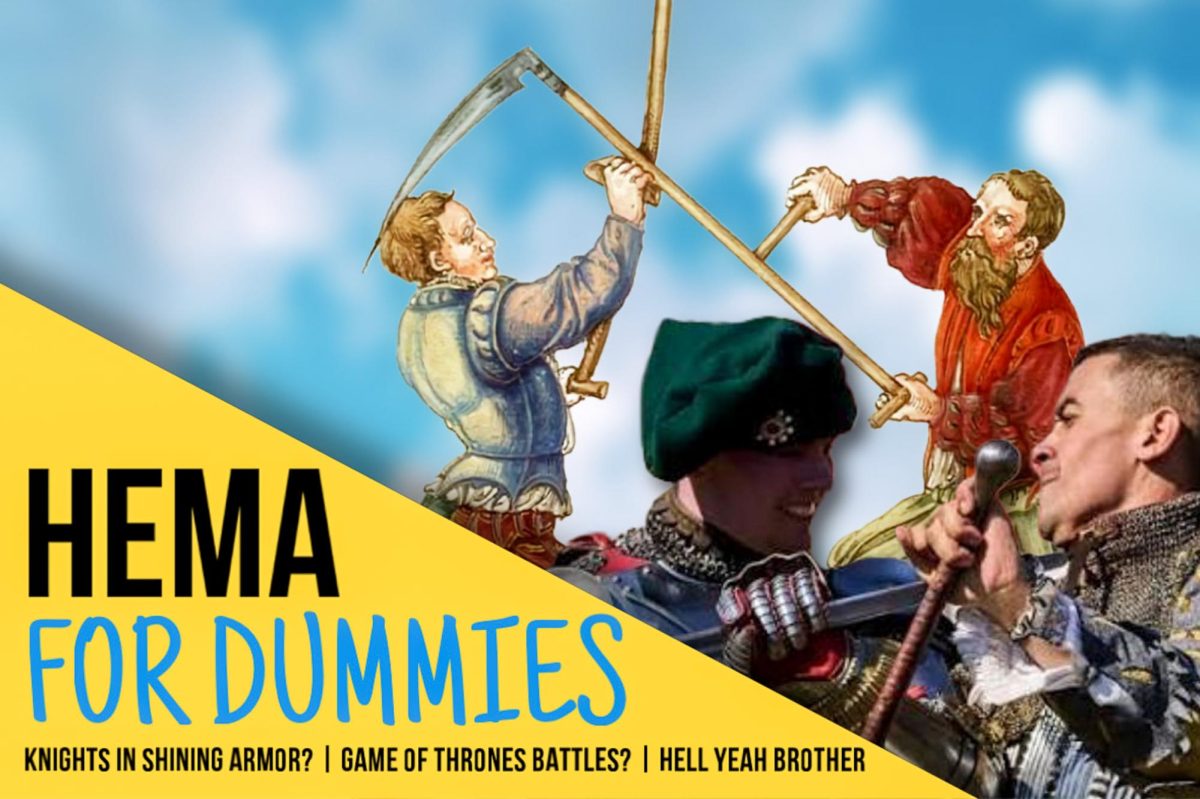
It’s like CrossFit, but everyone is wearing chainmail. You’ll burn calories, make friends and probably question your life choices somewhere between sword swings. // Graphic by Justin Shaw
Have you found yourself having the desire to become a knight in an age where nearly all knightly gear is obsolete, and no professional knightly guild exists? If so, the loose grouping of Historical European Martial Arts (HEMA) is there to lead you into your somber fantasy dreams. With swords, bows and other medieval-esque weapons (but mostly swords), HEMA is full of adventure.
Paralleling its iconic status, HEMA focuses on sword fighting, referencing the medieval veneration of the longsword. However, there is a presence in the fighting scene for more obscure weaponry, such as halberds, lances, crossbows and advanced shield techniques. Since the 1980s, HEMA has grown in popularity alongside the rise of the internet, largely through passionate grassroots efforts.
Given that many countries have had the concept of pointy weapons, many styles and classes of weaponry are grouped under the umbrella of HEMA. Most focus on medieval and Renaissance traditions, or even on country-specific traditions, such as the German long sword Schielhau. Classical sources, such as ancient Greek wrestling or chariot racing, tend to be limited compared to sources between 1300 and 1900.
HEMA tends to attract interest in medieval and Renaissance eras. Traditions drawn from known sources have spawned German, Italian and Spanish traditions for more medieval and Renaissance pursuits, with Scottish, English and French for 18th and 19th-century modern fencing practices.
HEMA, being a historical art, draws on historical texts. Book recommendations may be modern or pre-modern, such as “The Art of Combat” (1570) or “The Schielhau in Detail” (2025). Sometimes, the art must be reconstructed from history.
Historically, these arts were passed down from master to student, but advances in technology and the Industrial Revolution began to erode the need for such a process. Modern tournaments also exist, and with modern safety standards, people are less likely to be injured compared to times in the past. Some of these tournaments are traveling, increasing accessibility to a niche art form.
There is no central structure for HEMA; however, clubs and institutions exist to promote the arts. Most clubs focus entirely on swords, though some seek to incorporate armored combat and other obscure art forms, and others try to bridge HEMA into underrepresented groups.
HEMA is continually growing worldwide, with countries such as Italy offering several traditions of the longsword and the unique Venetian rapier to learn. YouTube has further broadened HEMA with free tutorials on several traditions related to various classes of weaponry. Regulations are slimmer than in more traditional sports, and tend to be group-by-group.
In Grand Junction, a newer HEMA club called Raven’s Edge HEMA teaches the traditions of Lichtenaur and Meyer, two German styles of the longsword. The club is temporarily closed due to recovery from COVID-19. Another club, The Black Falcon School of Arms, is currently active in Colorado Springs. Denver Historical Fencing offers HEMA focused on historical fencing arts rather than the usual longsword focus. The Colorado HEMA scene may continue to grow alongside global interest in western martial arts.
One of the professional peaks of HEMA is knighthood in the professional show. Knights perform in scenes such as Medieval Times, often on horseback, to fight other knights in competition. Weapons may be traditional lances to an eight-foot-long alabarda, all for performances to entertain medieval and fantasy enthusiasts.
Beginning as squires, future knights are trained in equestrian arts and fighting, and typically wear heraldic clothing into battle. They are then paid to perform at events in feats of skill, equestrianism, knowledge, charisma and physical prowess using historically inspired weapons.
Fantasy tends to be the main catalyst of HEMA. The ability to step into another time, with the body and steel in hand, allows for a new experience of the present and the past. HEMA groups tend to be dedicated to understanding and living out historical realities, with many others inspired to join due to European-inspired fantasy works such as “Game of Thrones,” which depict the longsword more accurately as a nimble weapon rather than a brutish sword.
Professional infrastructure is set to grow, especially as people begin to seek fantasy amid modern strife.